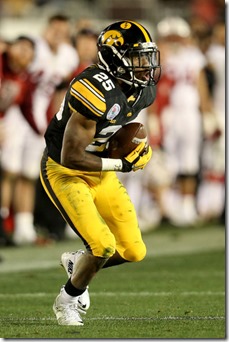2017 iowa
For 2017, instead of previewing conferences division-by-division, I decided to preview the 64 Power Five teams individually, so I ranked them and counted down from the bottom.
I created a ranking system based heavily off of Bill Connelly’s S&P+ rankings: half of the ranking comes from the S&P rankings from the past five seasons among Power Five teams (1/3 of that number is 2016’s ranking; 1/3 is the average from 2014-2016, 1/3 is the average from 2012-2016); half comes from two component parts of his 2017 S&P+ projections, weighed evenly – recruiting impact and returning production – and ranked 1 through 64. The ranking itself skews towards emphasizing where the teams were according the 2016 S&P+ and there’s no subjectivity involved. I think it serves as a decent way to sequence these previews.
Previously: #64 Purdue, #63 Rutgers, #62 Kansas, #61 Illinois, #60 Boston College, #59 Virginia, #58 Vanderbilt, #57 Syracuse. #56 Maryland, #55 Arizona, #54 Wake Forest, #53 Duke, #52 Iowa State, #51 Texas Tech, #50 Missouri, #49 Oregon State. #48 Arizona State, #47 Cal, #46 Indiana, #45 Kentucky, #44 West Virginia, #43 South Carolina, #42 Washington State, #41 Northwestern.
(I didn’t include Notre Dame)
40. MINNESOTA
#4 Big Ten West, #8 Big Ten
9-4 (5-4) in 2016
It’s impossible to talk about Minnesota football without talking about how Tracy Claeys got fired after just one season as the head coach: he supported a player boycott in response to an investigation into appalling sexual assault allegations against members of the football team. The players wound up playing in the Holiday Bowl after threatening to sit it out; Claeys was fired after the New Year; some of the accused were expelled, some suspended, and some cleared.
PJ Fleck becomes the Gophers’ third head coach in three seasons – and it was a coup for the program to get a coaching prospect of his caliber who had been mentioned in connection with better jobs. Fleck and his energetic persona brought Western Michigan to unprecedented heights: the Broncos had an undefeated regular season in his fourth year in Kalamazoo and made the Cotton Bowl, built by a talent advantage he created by outrecruiting the rest of the MAC by a sizable margin.
He brought his offensive coordinator Kirk Ciarrocca, and while the Gophers will be moving to more of a spread attack, they’ll still be running the ball a ton: RBs Rodney Smith and Shannon Brooks totaled 378 carries a season ago and WMU ran the ball often with zone blocking schemes with Fleck and Ciarrocca in charge, setting up favorable coverages for their All-American WR Corey Davis. Minnesota will be choosing from a number of unproven quarterbacks and their only credible WR from last season is gone. If former Ohio State OL coach Ed Warinner works his magic with a cast of inexperienced if uninspiring linemen, Smith and Brooks will be leaned on all the more heavily. Minnesota does have one of the best kickers in the country in Emmitt Carpenter.
Minnesota got to a 9-4 record last season because of its defense – they won the scandal-marred bowl game over Washington State 17-12 in stereotypical Big Ten fashion. They have Steven Richardson back, a disruptive interior linemen who had seven sacks a season ago – potentially one of the best players in the Big Ten. Additionally, LBs Jonathan Celestin and Cody Poock as well as safeties Duke McGhee and Antoine Winfield Jr. make those above-average position groups. There are some holes though: cornerback is very unsettled and the defensive line outside of Richardson looks to be rather mediocre. If the defense can replicate what they did in 2016, Minnesota could challenge for the Big Ten West – but attrition makes that unlikely.
The schedule sets up nicely for Fleck, at least to start – the toughest game in the first half of the season is either @ Oregon State or home vs. Michigan State. The stretch run is brutal, with road trips to Iowa, Michigan, and Northwestern, as well as home games against Nebraska and Wisconsin – the Big Ten West frontrunner. It’s not hard to envision a team with a gaudy record, maybe even 7-0, faltering down the stretch; it’s also possible that a trip to Indianapolis could be at stake when they host the Badgers in the regular season finale.
Fleck will need to find a passing game – and the run game will have to be much better at keeping the offense on schedule. If he can cobble together a decent offense and keep the defense at a reasonably high level, they could surprise in his first year. That’s a lot to ask – they’ll probably finish near the middle of the West.
39. IOWA
#3 Big Ten West, #7 Big Ten
8-5 (6-3) in 2016
With Bob Stoops’s unexpected retirement, Kirk Ferentz is college football’s coach with the longest continuous tenure (as Bill Snyder briefly retired from his job at Kansas State). He’s entering his 19th season at Iowa; over his career, he’s posted a record of 135-92 – that would average out to 7.7 wins per 13-game season. Ferentz has had a few especially strong years – most recently in 2015, when they went undefeated through the regular season (before losing the Big Ten Championship Game and the Rose Bowl) – but most years, he’s squarely in 7-5 / 8-4 territory.
2016 was up-and-down: Iowa lost to North Dakota State (an FCS powerhouse, but still) in September and only scored 14 points in a win over Rutgers the following week; they were drubbed at Penn State and turned around to pull one of the biggest upsets of the season over then-undefeated Michigan on a last-second field goal; they crushed a 9-4 Nebraska team to close out the season and were blown out by Florida in the bowl game, 30-3.
Both halves of their RB platoon went for over 1,000 yards and had 10 rushing touchdowns each, and the passing game was mediocre, especially after the early-season injury to WR Matt VandeBerg (who took a medical redshirt). Iowa figures to rely heavily on its veteran OL – that’s particularly strong on the right side – and its RBs. LeShun Daniels is gone, but Akrum Wadley is back, and the latter showed more big-play potential than the former a year ago. The Hawkeyes also added Nevada transfer James Daniels, Nevada’s best player on offense in 2016, to the mix – whatever percentage of the carries he and Wadley each get remains to be seen, but they’ll run the ball so often that both will play prominent roles. Whoever wins the QB job (and whoever it is, they’ll be unproven) will be handing the ball off a lot.
The defense returns quite a few pieces, though they did lose star CB Desmond King and disruptive DT Jaleel Johnson. LB Josey Jewell is the best player on the defense – he’s an instinctive middle linebacker who’s stout against the run and had 124 tackles last season. The defensive line is mostly intact outside of Johnson, and Anthony Nelson has potential as a pass-rusher. The secondary looks shaky, as Brandon Snyder, an excellent safety, tore his ACL in the spring. Iowa’s defense will probably be pretty good – like it almost always is under Ferentz.
The QB situation and dearth of proven and healthy WRs are good reasons to be skeptical of Iowa’s chances of winning the West. Penn State and Ohio State come to play in Iowa City from the East in 2017, an unfortunate scheduling disadvantage. Ferentz promoted his son from OL coach to coordinator, a sign that things are unlikely to change much. Odds are that this will be a classic Ferentz team: strong running game, good defense, and seven or eight wins.
[33-38 after the JUMP]
48